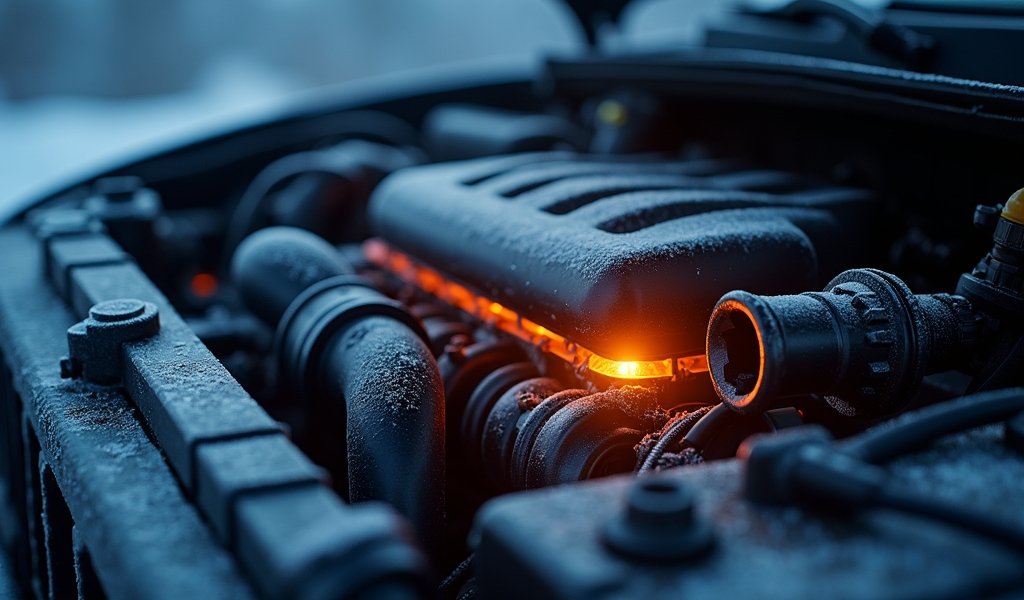Overview
This article offers practical solutions for diesel engine cold start problems, focusing on five key repairs: checking fuses, fixing corroded wiring, testing relays, resetting the engine control module, and maintaining glow plugs. It emphasizes both DIY approaches and knowing when to seek professional help, while providing preventative maintenance tips to avoid cold weather starting issues altogether.
Table of Contents
- Frosty Mornings, Fiery Fixes: Understanding Cold Start Glow Plug Timer Issues
- Fantastic Fuse: First Fix for Your Frigid Engine Woes
- Wicked Wiring Woes: Conquering Connection Conundrums
- Remarkable Relay Rescue: Testing and Triumph
- Electronic Enchantment: Resetting Your Engine’s Brain
- Glowing Greatness Again: Cleaning or Replacing Your Glow Plugs
- The Professional Path: When to Wave the White Flag
- Prevention Paradise: Keeping Cold Starts Carefree
- Conclusion
- Frequently Asked Questions
Frosty Mornings, Fiery Fixes: Understanding Cold Start Glow Plug Timer Issues
When winter’s wrath wraps around your diesel engine like a frigid blanket, your cold start glow plug timer becomes the unsung hero of your morning commute. These mighty little marvels are the spark of life in diesel’s chilly heart, warming combustion chambers to temperatures that coax reluctant fuel into ignition. But when this critical component throws a tantrum, your morning ritual transforms from simple key-turning to an exercise in patience and profanity.
As a diesel technician with frost-bitten fingers from countless winter repairs, I’ve seen the frustration flash across drivers’ faces when their trusty trucks refuse to rumble to life. The silent treatment from your diesel engine on a frigid morning isn’t just inconvenient—it’s downright infuriating. The good news? You don’t need to be a mechanical magician to solve many cold start glow plug timer troubles.
In this guide, we’ll walk through five fixes that flow from simple to sophisticated, each addressing common cold start glow plug timer issues. Like a doctor diagnosing a patient, we’ll start with the obvious symptoms before diving deeper into the diesel’s dilemmas. By the end, you’ll be armed with the knowledge to battle the bitter cold and bring your diesel roaring back to life—even when the mercury takes a nosedive.
Fantastic Fuse: First Fix for Your Frigid Engine Woes
Like silent sentinels standing guard over your vehicle’s electrical system, fuses are the first line of defense—designed to sacrifice themselves so more expensive components can live to see another day. When your diesel’s morning ritual turns troublesome, checking these tiny guardians should be your first port of call.
The fuse protecting your cold start glow plug timer typically hides in your vehicle’s main fuse box—sometimes under the hood, sometimes lurking behind a dashboard panel. Your owner’s manual becomes your treasure map here, guiding you directly to the prize. When this particular fuse fails, the symptoms speak volumes: absent glow plug indicator lights, marathon cranking sessions, or the dreaded silence of complete starting failure when temperatures plummet.
Fuse checks are beautifully simple, even for the mechanically challenged. Turn off your engine, locate your fuse box, and use the fuse puller (often included right in the box) to gently extract the suspect. Hold it up to the light like a diamond merchant examining a gem—if the metal strip inside is broken, you’ve found your culprit. Replacing it with a fresh fuse of identical amperage rating often solves the problem faster than you can say “winter wonderland.”
This five-minute fix can save you hundreds in unnecessary diagnostic fees and the headache of more invasive repairs. It’s the automotive equivalent of checking if your computer is plugged in before calling IT support—simple but surprisingly effective.

Wicked Wiring Woes: Conquering Connection Conundrums
Electrical connections in a diesel engine are like relationships—they require maintenance, degrade when neglected, and occasionally need a clean start. The invisible villain called corrosion silently sabotages your cold start glow plug timer’s performance, building resistance where electricity should flow freely.
Following the wiring from your timer to the glow plugs is like tracking breadcrumbs through a forest. Look for the telltale signs of trouble: greenish-white powder (corrosion’s calling card), connections that wiggle like loose teeth, or insulation cracked and peeling like sunburned skin. These symptoms often multiply in vehicles that have weathered many winters or worked in harsh environments, where salt and moisture conspire against electrical integrity.
When you find these troubled spots, transformation begins with proper cleaning. Disconnect your battery (safety first—electricity bites!) and gently separate the affected connectors. A wire brush becomes your magic wand, sweeping away corrosion’s stubborn remnants. For connections as crusty as week-old bread, a paste of baking soda and water works wonders, neutralizing acidic buildup.
After cleaning connections until they shine like new dimes, apply dielectric grease—a thin layer of this miracle substance prevents future corrosion like a force field. Reconnect everything firmly until that satisfying click confirms proper seating. When you finally reconnect the battery and turn the key, the difference can be dramatic—like switching from dial-up to fiber internet.
Clean connections can transform your diesel from a reluctant starter to an eager performer, especially when engine coolant temperatures drop to challenging levels. This maintenance magic costs little more than time and elbow grease but delivers results worth their weight in gold on frosty mornings.
Remarkable Relay Rescue: Testing and Triumph
The glow plug relay—a modest component with mighty importance—serves as the orchestral conductor of your starting symphony. This electromagnetic switch receives signals from your cold start glow plug timer and directs power to your glow plugs with precision timing. When functioning flawlessly, it announces its operation with a distinctive click that’s music to a diesel owner’s ears.
Finding this critical component requires another consultation with your vehicle’s owner’s manual—your faithful Sherlock to help solve the mystery of its location. Typically, it resides in the engine compartment, often in a relay box nestled near the fuse panel or mounted on the firewall like a sentry.
Testing this component transforms you from frustrated driver to diagnostic detective. With a digital multimeter as your magnifying glass, you’ll measure continuity and resistance across terminals to determine if your relay deserves retirement. A properly functioning relay should show infinite resistance at rest and near-zero resistance when activated—like a door that’s either completely closed or wide open with no in-between.
Signs of a failing relay read like symptoms of a seasonal illness: no clicking sound when the key turns, clicking without resulting action, intermittent operation, or physical evidence of electrical distress like melted plastic or burn marks. Replacement is refreshingly straightforward—most relays simply plug into their socket like electronic building blocks.
After replacing a faulty relay, turning the key becomes an experience filled with anticipation rather than dread. That confident click followed by your engine’s rumbling awakening feels like victory against winter’s worst—a triumph of persistence over freezing resistance.
As diesel fuel injection experts often note, the relay system is critical for proper pre-heating cycles, especially in modern high-pressure common rail systems that demand precise timing coordination. Ensuring this component functions flawlessly pays dividends in starting reliability when temperatures plummet.
Electronic Enchantment: Resetting Your Engine’s Brain
Modern diesel engines rely on electronic control modules (ECMs) that make NASA’s early computers look primitive by comparison. These silicon brains orchestrate everything from fuel delivery to glow plug timing with millisecond precision. Like any complex computer, sometimes the solution to mysterious gremlins is simply turning it off and on again—the universal IT solution applies to vehicles too!
Consider an ECM reset when you’ve replaced physical components but still face stubborn starting issues, when your glow plug light flickers like a haunted house attraction, or after battery disconnection has wiped your ECM’s memory cleaner than a freshly formatted hard drive. This digital detox can clear corrupted data and restore factory settings, giving your diesel a fresh perspective on life.
The reset procedure resembles a sacred ritual: disconnect the negative battery terminal (always negative first—positive connections can create sparks that dance too close to flammable materials), flip on your headlights to drain residual power like emptying a bathtub, then wait. Patience becomes virtue here—fifteen minutes minimum, though many seasoned mechanics swear by longer periods for complete system amnesia.
Reconnection follows specific choreography: positive terminal first, then negative, followed by turning the key to the “on” position without starting. This limbo state allows systems to initialize, like stretching before a marathon. Your intake air temperature sensor and other monitoring systems will recalibrate during this period, establishing their baseline readings.
After this electronic cleansing, many mysterious ailments vanish like morning fog under sunshine. Your glow plug indicator should behave predictably, cold-start performance improves, and electrical oddities retreat. This solution costs nothing but time yet can save hundreds in unnecessary parts replacement—truly a mechanic’s elegant solution to complex problems.

Glowing Greatness Again: Cleaning or Replacing Your Glow Plugs
Sometimes the villain in your cold-start saga isn’t the timer or relay but the glow plugs themselves—those hardworking heating elements that toil in your engine’s combustion chambers like miniature blacksmiths. Like lightbulbs in your home, these components have a finite lifespan before they flicker and fade.
The warning signs of glow plug decline speak in a language of smoke and struggle: white exhaust plumes that linger longer than your morning coffee break, a starting routine that requires multiple attempts like learning a difficult dance, or rough idling that smooths only after your engine warms up like muscles after exercise. These symptoms often intensify as temperatures drop, revealing weakness in your starting system.
Testing individual glow plugs requires glow plug resistance testing with your trusty multimeter. After removing electrical connections (with the battery disconnected—safety remains paramount), measure each plug’s resistance and compare it to specifications in your service manual. Significant deviations from these values suggest a plug past its prime, while visual inspection might reveal damage or deposits like archaeological evidence of hard living.
For plugs suffering only from carbon buildup—like arteries narrowed by poor diet—cleaning may resurrect function. Gentle attention with a wire brush and brake cleaner can remove deposits, restoring conductivity and performance. However, when resistance readings stray far from specification or physical damage appears, replacement becomes the only viable path forward.
Consider glow plugs as a synchronized team rather than individuals—replacing the entire set ensures balanced performance across all cylinders, like changing all tires rather than just one worn treader. Quality matters enormously here; premium plugs from reputable manufacturers may cost more initially but deliver reliability worth every penny when temperatures plunge to polar levels.
According to Engine Labs research, modern ceramic glow plugs reach operating temperatures in seconds rather than minutes, making them vastly superior to older metallic designs for cold-weather performance. This investment in quality components pays dividends every winter morning.
The Professional Path: When to Wave the White Flag
While DIY diesel repair brings satisfaction like successfully assembling furniture without leftover parts, sometimes professional intervention becomes necessary. As a mechanic who’s seen the aftermath of ambitious amateur repairs gone wrong, I can tell you that knowing when to call in reinforcements is wisdom, not weakness.
Consider waving the white flag when you’ve applied all five fixes with the determination of a marathon runner yet your engine still protests like a stubborn mule. Warning signs demanding professional attention include fuel contaminating your engine oil (creating a rising dipstick level and distinctive diesel aroma), excessive white smoke that persists long after warm-up, mysterious knocking sounds like ghostly woodpeckers, or diagnostic codes pointing to injection timing issues beyond DIY territory.
Cost considerations become important crossroads in your decision-making journey. While DIY repairs typically range from $20-$200 depending on which components need replacement, professional diagnosis and repair generally falls between $200-$800. However, attempting repairs beyond your skill level risks creating expensive complications—turning a $300 professional repair into a $1,500 nightmare faster than you can say “I thought I could fix it myself.”
Finding the right diesel specialist resembles dating—chemistry and communication matter. Look for shops with specific diesel experience (not just general automotive), ASE-certified technicians with diesel specializations, positive reviews from fellow diesel owners, and most importantly, professionals who explain issues without condescension or unnecessary jargon.
Remember that even skilled DIYers sometimes need specialized diagnostic equipment that costs thousands of dollars—tools that professional shops already possess. Sometimes paying for expertise actually saves money in the long run, like hiring a guide in unfamiliar territory rather than wandering lost for days.
Prevention Paradise: Keeping Cold Starts Carefree
The ancient wisdom that prevention trumps cure applies perfectly to diesel cold-start systems. Preventative maintenance transforms from boring chore to brilliant strategy when you’re not the one standing in a freezing parking lot while others drive happily away.
Cold weather preparation should begin before the first frost kisses your windshield. Battery maintenance deserves special attention since your glow plugs draw current like thirsty travelers at an oasis. Have your battery tested before winter arrives—a battery that performs adequately in summer may surrender when temperatures plummet. Clean terminals until they shine like new silver, and consider a battery tender for vehicles that hibernate between uses.
Fuel quality becomes crucial when temperatures drop like stones. Premium diesel fuel additives with anti-gel properties prevent your fuel from turning to sludge in extreme cold—like antifreeze for your fuel system. A quality cetane booster improves cold-weather combustion properties, making your engine more eager to start when Jack Frost nips at your fuel lines.
For those in areas where winter shows no mercy, engine block heaters transform from luxury to necessity. These devices warm your engine’s core components before you ever turn the key, reducing wear and dramatically improving starting reliability. The small electricity cost pales compared to the benefit of confident cold-weather starting.
Switching to manufacturer-recommended winter-grade oil reduces internal resistance when temperatures plummet, allowing your starter to crank more effectively and your glow plugs to receive maximum current. Think of it as dressing your engine in appropriate winter clothing—the right protection for the conditions.
This preventative approach might seem excessive during warmer months, but when temperatures drop and vehicles around you refuse to start, your foresight will feel like automotive enlightenment. As professional mechanics often observe, we see far fewer winter starting issues in vehicles maintained with cold weather in mind.
Conclusion
Cold start glow plug timer issues transform diesel engines from reliable workhorses to stubborn mules, but armed with these five fixes, you’re now equipped to battle winter’s worst. From simple fuse checks that take minutes to more involved glow plug replacements, each solution addresses a common failure point in your starting system’s chain of command.
Remember that your diesel’s cold start system operates like a well-rehearsed orchestra—each component plays its part in perfect timing. When one musician misses a note, the entire performance suffers. Regular maintenance isn’t just about preventing breakdowns; it’s about ensuring your vehicle starts reliably when temperatures take a nosedive.
Whether you choose the DIY path or seek professional assistance, understanding these systems empowers you to make informed decisions about your diesel’s care. Cold mornings no longer need to fill you with dread—not when you have the knowledge to diagnose and address common cold start glow plug timer issues.
As winter approaches, consider implementing the preventative measures we’ve discussed. Like preparing your home for winter storms, preparing your diesel for cold weather demonstrates foresight that pays dividends in reliability and reduced repair costs. Your future self, standing in a frost-covered parking lot with a diesel that starts on the first try, will thank you for your diligence.
Frequently Asked Questions
How do I know if my glow plug timer is bad?
A faulty glow plug timer typically causes excessive cranking before starting, especially in cold weather, and may prevent the glow plug indicator light from illuminating or turning off properly. You might also notice white exhaust smoke that persists longer than normal during cold starts.
Can I drive with a bad glow plug timer?
Yes, you can drive with a bad glow plug timer once the engine is running, but starting will be increasingly difficult, especially in cold weather. Continued operation may cause excessive wear on your starter and battery due to extended cranking times.
How much does it cost to replace a glow plug timer?
Replacement glow plug timer costs range from $50-$200 for the part alone, with professional installation adding another $100-$250 depending on vehicle accessibility. DIY replacement can save on labor costs if you have moderate mechanical skills.
How long do glow plug timers typically last?
Most glow plug timers last between 80,000 to 100,000 miles under normal conditions. Environmental factors like extreme temperatures, moisture exposure, and electrical system issues can significantly reduce this lifespan.
Can a bad glow plug timer drain my battery?
Yes, a malfunctioning glow plug timer can drain your battery by either keeping glow plugs activated longer than necessary or causing excessive cranking attempts. A timer stuck in the “on” position will continuously draw current, potentially depleting your battery overnight.

